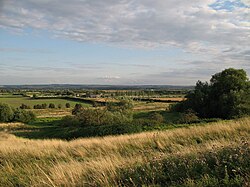Croydon, Cambridgeshire
| Croydon | |
| Cambridgeshire | |
|---|---|
 All Saints Church, Croydon | |
| Location | |
| Grid reference: | TL314497 |
| Location: | 52°7’48"N, 0°4’48"W |
| Data | |
| Population: | 221 (2001) |
| Post town: | Royston |
| Postcode: | SG8 |
| Dialling code: | 01223 |
| Local Government | |
| Council: | South Cambridgeshire |
Croydon is a village in south-western Cambridgeshire, 10 miles south-west of Cambridge and 6 miles north-west of Royston. The village is immediately west of the A1198 road, the Roman Ermine Street. The population in 2001 was 221 people.
The site of the deserted mediæval village of Clopton is in Croydon parish, which was formerly known as Croydon-cum-Clopton.
The River Rhee (or Cam, one of two tributaries which claim the main river's name for itself) runs along the southern boundary of Croydon parish.[1] The soil at Croydon is marl with a chalk and gault subsoil.[2]
The village's name was spelled Crauudene in the 1086 Domesday Book and is derived from the Old English crawe denu, meaning 'crow valley’.[3] The parish is named simply "Croydon", but formerly it was known as "Croydon-with-Clopton" or "Croydon-cum-Clopton", as it included the deserted village of Clopton.[2]
Three buildings in the parish are listed: the parish church, a row of cottages along Larkins Road and a milestone along Tadlow Road.
History
In 1086, about 28 farmers and labourers lived at Croydon. The separate parishes of Croydon and Clopton were joined in 1561 and Croydon's population may have increased to around 140 people early in the 17th century, but fell to 90 during the reign of Charles II. Open fields surrounding Croydon village were inclosed for pasture around 1640, but from the late 18th century arable farming began once more.[1]
Today’s Croydon grew up along a street which runs east-west along the ridge to the north of the parish. Some timber-framed houses dating from the late 17th or early 18th centuries still stand, though most of the cottages date from the early 19th century. The main route through the parish followed a terrace along the steep hillside towards Tadlow. The track, called 'Royston road', was improved and incorporated into the Cambridge to Biggleswade turnpike, which is now the B1042. Croydon Old Lane, in the north, went towards Hatley, while the current road up Croydon Hill to Hatley was first built in 1830.[1]
Clopton

Clopton was a village which was deserted in the 16th century. Its site has been designated a Scheduled Ancient Monument and is west of Croydon village; a footpath known as the 'Clopton Way' runs past it. There were signs of Roman occupation at Clopton and a 30-acre Anglo-Saxon village was in place by the 10th century. It was mentioned in the 1086 Domesday book, when 18 peasants were in residence. A Friday market was granted in 1292 to Robert Hoo, Lord of Clopton, and may have been held on the cobbled area found just north of the church.
The church and manor house of Clopton stood facing one another in the northern half of the village, whose main street, diverted around the churchyard after 1200, ran from north-east to south-west between them. (fn. 16) They were surrounded by the peasants' crofts, many of whose earthworks are still traceable.[1]
The village stood on a prominent ridge and was terraced into the hillside - archaeological excavations have revealed the former locations of a central church, two sites with moats and a probable mill. The site of the manor of Clopton, Clopton Bury, had a rectangular moat linked to the mill in the south-east of the village.
The village started to decline in the later Middle Ages and was deserted for good in the early 16th century after inclosure, which had begun around 1500,[1] deprived the villagers of their livelihood. By 1524, the only households left belonged to the lady of the manor and five labourers.[1] Today, earthworks outline the site of the village.[4]
Parish church
The Parish Church, All Saints, was built by the late 12th century. It stands on a slope above the village street and is constructed of brick and field stones in the Perpendicular style.[2] Its position though has caused subsidence and the structure shows the signs of repeated patching up of the stonework.
The nave is 13th century, and north and south aisles were added in the next century, followed by the west tower. Today’s chancel results from the later restoration of the church in the 17th or 18th century. There is no chancel arch.
The font is an interesting example from the twelfth century, carved in limestone.[5]
In a survey of church in 1561, the church was said to be in decay. Sir John Cage made efforts to improve it in the 1620s and Sir George Downing rebuilt the chancel in brick and established a family vault.[6]
Another church was built at Clopton in the late 12th century on a terrace; it was reconsecrated in 1352 and measured around 40 feet by 20 feet. It was in poor repair by the 1561 survey and was turned over to agricultural use before 1660 and was demolished: even the foundations were removed.[1]
War memorial
A war memorial stands on Church Lane and commemorates Croydon men who were killed in the First and Second World Wars.
References
- ↑ 1.0 1.1 1.2 1.3 1.4 1.5 1.6 'Parishes: Croydon cum Clopton', A History of the County of Cambridge and the Isle of Ely: Volume 8 (1982), pp. 30-42. Date accessed: 08 August 2008.
- ↑ 2.0 2.1 2.2 GENUKI: Croydon-with-Clopton
- ↑ Mills, A.D. (1998). A Dictionary of English Place-names. Second Edition. Oxford University Press, Oxford. p105. ISBN 0-19-280074-4
- ↑ Cambridgeshire County Council: Archaeological Sites in South Cambridgeshire
- ↑ Listed Buildings: Church of All Saints, Croydon
- ↑ Cambridgeshire Churches: All Saints, Croydon